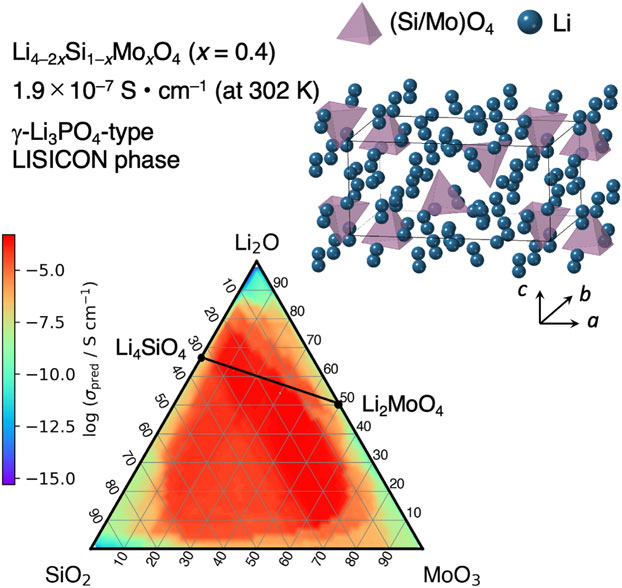- 著者
- Takuma Noda Hanseul Kim Kenta Watanabe Kota Suzuki Naoki Matsui Ryoji Kanno Masaaki Hirayama
- 出版者
- The Ceramic Society of Japan
- 雑誌
- Journal of the Ceramic Society of Japan (ISSN:18820743)
- 巻号頁・発行日
- vol.131, no.10, pp.651-658, 2023-10-01 (Released:2023-10-01)
- 参考文献数
- 27
The reaction distribution in the composite cathode of an all-solid-state battery (ASSB) was directly tracked by in situ scanning electron microscopy (SEM) combined with energy dispersive X-ray spectroscopy (EDX). Contact between an electrode active material and a solid electrolyte is important for improving the properties of ASSBs as a promising next-generation battery. An in situ analysis is significant for establishing strategies to obtain sufficient contact areas between the active material and solid electrolyte particles. SEM-EDX has the advantages of in-situ measurement in spatial/time resolution, non-destruction, and versatility. We investigated the sensitivity of EDX to the Na signal and distinguishable distance to ensure sufficient spatial/time resolution. The acceleration voltage of 5 kV for the electron beam provided the highest sensitivity to the Na signal among all acceleration voltages. The distinguishable distance decreased with increasing magnification owing to the decrease in pixel size. Cross-sectional SEM-EDX images of the TiS2–Na3PS4/Na3PS4/Na–Sn cell were collected during charge/discharge. The time variation of Na signal intensity confirms the deintercalation of Na+ in the TiS2–Na3PS4 cathode layer. Moreover, intercalation on the solid electrolyte side proceeded faster than that on the current collector side. This was because the rate-determining step was ionic conductivity rather than electronic conductivity based on the difference between ionic and electronic conductivities. Ex situ observations detected only a uniform distribution in the composite after Na+ diffusion had relaxed. Operando SEM-EDX is a new tool to directly explore the intermediate conditions of electrode materials under ASSB operation.
2 0 0 0 OA Search for Lithium Ion Conducting Oxides Using the Predicted Ionic Conductivity by Machine Learning
- 著者
- Yudai Iwamizu Kota Suzuki Naoki Matsui Masaaki Hirayama Ryoji Kanno
- 出版者
- The Japan Institute of Metals and Materials
- 雑誌
- MATERIALS TRANSACTIONS (ISSN:13459678)
- 巻号頁・発行日
- vol.64, no.1, pp.287-295, 2023-01-01 (Released:2022-12-25)
- 参考文献数
- 42
- 被引用文献数
- 1
A machine learning method was developed, which predicts ionic conductivity based on chemical composition alone, aiming to develop an efficient method to search for lithium conductive oxides. Under the obtained guideline, the material search was focused on the Li2O–SiO2–MoO3 pseudo-ternary phase diagram, which is predicted to have high ionic conductivity (>10−4 S·cm−1). We investigated the formation range, ionic conductivity, and crystal structure of the lithium superionic conductor (LISICON) solid solution on the Li4SiO4–Li2MoO4 tie line. The ionic conductivity of the LISICON phases is about 10−7 S·cm−1, which is higher than that of the end members; however, two orders of magnitude lower than that of the analogous LISICON materials. In addition, the experimental values were two or three orders of magnitude lower than the predicted conductivity values by machine learning. However, the developed prediction model can be used as an initial guideline for material exploration since the predicted values follow the trend of practical conductivity in the phase diagram. The crystal structure analysis indicated that the distance between the lithium sites and the occupancy of each lithium site in the crystal structure contributed to the decrease in ionic conductivity. This strong correlation between crystal structure and ionic conductivity was one of the reasons for the discrepancy between the predicted ionic conductivity based on chemical composition alone and the experimental value. This Paper was Originally Published in Japanese in Japan Soc. Powder Powder Metallurgy 69 (2022) 108–116.
- 著者
- Kota Suzuki Jinan Cui Jiang Peilu Hanseul Kim Yumi Yamaguchi Satoshi Hori Masaaki Hirayama Ryoji Kanno
- 出版者
- The Ceramic Society of Japan
- 雑誌
- Journal of the Ceramic Society of Japan (ISSN:18820743)
- 巻号頁・発行日
- vol.131, no.10, pp.717-722, 2023-10-01 (Released:2023-10-01)
- 参考文献数
- 20
In this study, high-sulfur-containing carbon replica (sulfur-rich S-CR) composites were prepared using a melt-diffusion method. Melt diffusion under vacuum enabled the introduction of four times the weight ratio of sulfur into the mesopores of a carbon replica (CR). The obtained sulfur-rich S-CR exhibited an initial discharge capacity of 700 mAh gsulfur−1, indicating the low utilization of sulfur in the composite. The classification of the particle sizes of the solid electrolyte and CR contributed to the improvement in electrochemical performance. An initial discharge capacity of over 1,200 mAh g−1 was confirmed for the S-CR composite using the smaller solid electrolyte and CR prepared via a dry classification process. An analysis of the effect of the additives indicated that the rational design of electronic and ionic conduction pathways is required for higher cycle performance when using sulfur-rich S-CRs.
- 著者
- Takumi Yabuzaki Miho Sato Hanseul Kim Kenta Watanabe Naoki Matsui Kota Suzuki Satoshi Hori Kazuhiro Hikima Satoshi Obokata Hiroyuki Muto Atsunori Matsuda Ryoji Kanno Masaaki Hirayama
- 出版者
- The Ceramic Society of Japan
- 雑誌
- Journal of the Ceramic Society of Japan (ISSN:18820743)
- 巻号頁・発行日
- vol.131, no.10, pp.675-684, 2023-10-01 (Released:2023-10-01)
- 参考文献数
- 36
- 被引用文献数
- 1
Sulfide-type solid electrolytes for all-solid-state lithium-ion batteries are required to have high ionic conductivity, high (electro) chemical stability, and suitable mechanical properties. Compositing different materials is widely performed in developing multifunctional materials. However, only a few studies have investigated sulfide electrolytes due to the concern of lowering ionic conductivity. In this study, composite electrolytes comprising Li10GeP2S12 (LGPS)-type electrolytes and nanosized Al2O3 are fabricated by a solid-state reaction. Al2O3 particles are mainly located in the voids between LGPS particles, whereas very limited oxygen content is substituted for sulfur in the LGPS structure. LGPS–Al2O3 composites exhibit ionic conductivities of ∼5 mS cm−1 without significant changes by compositing Al2O3. LGPS–Al2O3 composites are softer and have higher atmospheric stability than uncomposed LGPS. All solid-state cells that use air-exposed LGPS–Al2O3 as a separator layer exhibit an improved cycle retention compared with that using air-exposed LGPS. These results demonstrate that electrolyte compositing is an effective means of improving other properties while maintaining high lithium ionic conductivity.
